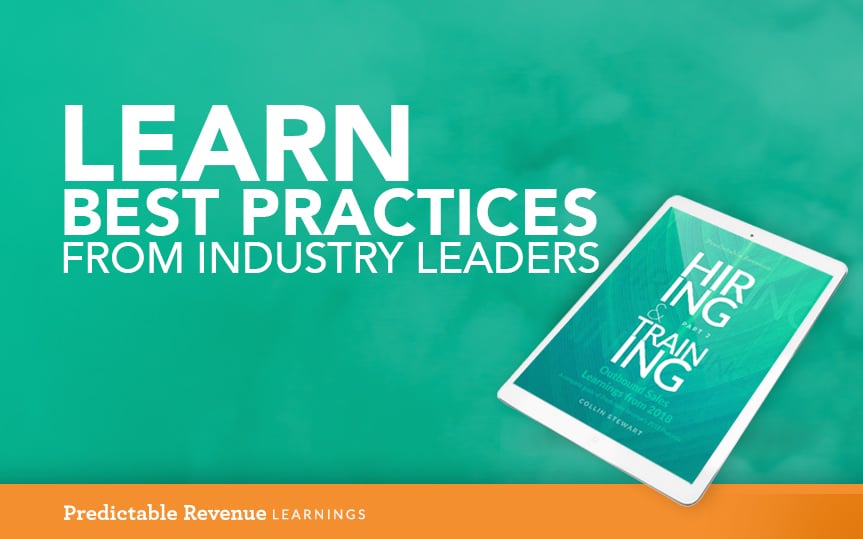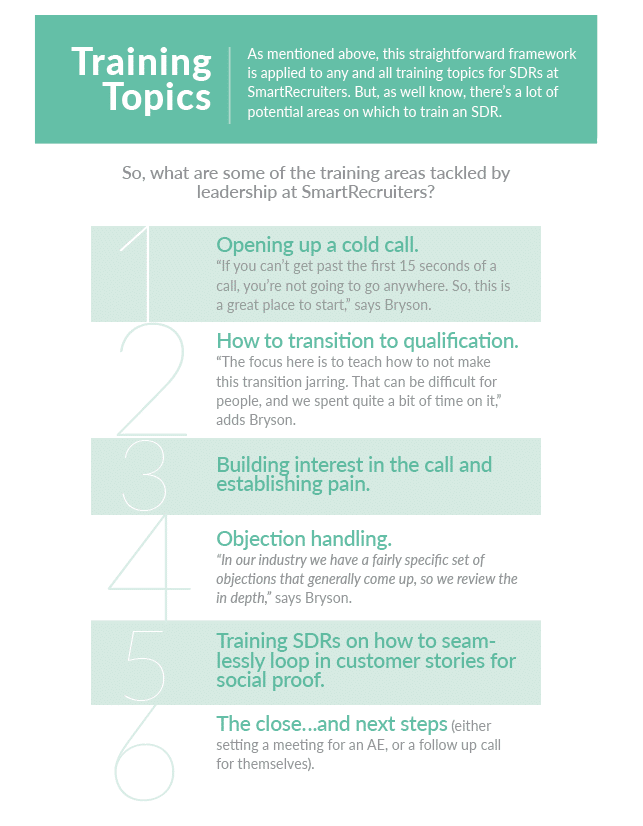Hiring and Training: Part 2 of Predictable Revenue’s Outbound Sales Learnings from 2018

When you’re in the sales development trenches, slugging it out day after day to meet your targets (and make some money!), it’s easy to get bogged down in the fundamentals of the job.
Is our messaging clear enough? Are we making enough calls? Sending enough emails? Can our objection handling be more effective?
To be clear, these are all great questions. And as sales professionals, we should be reviewing these topics regularly. But there’s more to building a well-oiled sales machine. You also need the right people.
For the topic of our second e-book, we decided to focus on how to attract, hire, and retain the team that executes your sales development playbook. Nailing this critical function is as important as crushing your numbers because, without an awesome sales development team, that rocket ship growth you’re planning will stall before takeoff.
The featured podcast guests in this e-book include:
- Sarah Affleck: Director of Sales Development at Rigor
- Mike Fiascone, Director of Sales Productivity at DocuSign
- Dominic Atkatz, Sales Development Manager at FLEXE
- Bill Binch, Chief Revenue Officer at Pendo
- Chris Bryson, Head of North American Sales Development at SmartRecruiters
- Joe Bisagna, Regional Sales Manager at Collibra
- Brian Gerrard, Director of Sales at Outreach
- Brian Wilson, Portfolio Operations Associate at Bregal Sagemount
- Aaron Ross, Co-Founder and Co-CEO of Predictable Revenue
- Matt Millen, Senior Vice President of Revenue at Outreach
Below is just a sample of what you can expect to get from a few these killer interviews:
Sarah Affleck: Director of Sales Development at Rigor
For a new rep to fully understand their critical job, sales leaders should take the time to discuss how that role fits within the larger context of the company. Yes, SDRs have to call, email, and book meetings.
But the gig is more than that, right? It’s supporting the company by creating pipeline. Revenue growth, a critical piece at every organization, starts with the SDR. That’s why Sarah Affleck, Sales Development Manager at Rigor, teaches every new sales hire the “why” behind their job.
Rigor does that by designing detailed onboarding process that not only encompasses training for a new hire’s respective role, but also offers a holistic look at each department in the company and how each of those parts works in unison to propel Rigor forward.
A key piece of that process is a thorough onboarding playbook, which covers initial schedules, departmental breakdown, company culture – to name just a few topics. This manual is as comprehensive as it gets.
“For SDRs, we have playbooks for everything – cold calls, sales development lifestyle, and shortcuts, to name just a few,” says Affleck.
“But in the overall onboarding doc, we really want to show both how the larger picture comes together, as well what each specific role does. For example, sales development is a critical role in sales, and we want to make sure we describe why that is, and share that with the rest of the company too.”
Mike Fiascone, Director of Sales Productivity at DocuSign
It’s important to be keenly focused and engaged at any job – and sales is no exception. To do this job well, you have to be on the ball. But that focus (and pressure!) can take a toll. Frustration, anger, burn out – all can, sadly, be symptoms of our profession.
For Mike Fiascone, Director of Sales Productivity at DocuSign, the key to staying balanced is regular meditation practice and a concerted effort to redirect negativity. Shifting your feelings in a more productive and positive direction, says Fiascone, comes down to three distinct steps:
- Seeing your emotions
- Feeling your emotions
- Hearing your emotions
For example, you’ve sent a contract to a potential client, and their procurement department has sent it back, challenging your quote. Your competition, they claim, is charging much less. They want you to do better, and get back to them within 24 hours.
As a result, you’re feeling a rush of anxiety, and a flurry of thoughts start running through your head – can I go cheaper? Do I want to go cheaper? And, how can I get this together quickly?
For Fiascone, this is when he closes his eyes and simply asks himself: “would I choose this anxiety?”
The answer, of course, is no. The anxiety is reflexive, stemming from our vault of autonomic reactions. But, instead of ignoring those difficult feelings, Fiascone closes his eyes and visualizes every image he can relating to this anxiety – losing the deal, getting fired etc. From there, he starts to focus on how that anxiety is affecting his body (what is he feeling? And, where is he feeling it?)
Finally, Fiascone listens closely to the parade of negative thoughts running through his head. Sure, those words can be difficult, even angry at times. But, those thoughts need space, he says. They too need to be heard.
Bill Binch, Chief Revenue Officer at Pendo
Modern sales culture – especially amongst the ranks of sales leadership – has become a data-drive environment. If we use the right tools, and implement them as we need, there isn’t anything we can’t know about the performance of our respective sales teams.
But, just as important as all of those data points, is the high-performing team needed to execute.
“From a big picture view, sales leadership has to make sure deals are closed, forecasting is done, and they teach the team to demo a particular tool in order to sell it. So, when you think of the role of selling, and where we spend most of our time, as sales leaders and managers, it is in that stuff,” says Bill Binch, Chief Revenue Officer at Pendo.
“The other most important thing, though, is to have people in the seat and trained up. This is just as important as all the functions of the job itself. If you think about world-class selling organizations, they always put a lot of thought into hiring.”
According to Binch, the first step on the road to successful (and efficient) hiring, is accurately profiling the kind of candidates you want to attract based on the values of your company.
“Really, what are the values that we have? Do you want gritty, hustlers? Or, do you want polished salespeople? Hire the ones that match your values,” says Binch.
“And make sure you hire against those values. That’s the key. Have the cultural values, make them public, and match your hiring to them.”
Pendo’s cultural values:
- Promote life outside of work
- Brutal Honesty
- Maniacal focus on the customer
- Biased to act
- Show me the data
- Be transparent
- Freedom and responsibility
Each of these pillars represents a component of life at Pendo. As such, the candidates Pendo hires are attracted to those values and are able to mesh with, and enhance, the team as a result.
“The best thing you can look for in a sales rep is a history of performance, and hustle. But, those are typical. Starting internally, and building from there, is critical,” says Binch.
“That’s where things can get unique and special.”
Chris Bryson, Head of North American Sales Development at SmartRecruiters

Matt Millen, Senior Vice President of Revenue at Outreach
It’s unclear when the trend started, but it’s become a prerequisite for all startup / technology / sales jobs to include a provision for “culture fit.”
Aside from the product a company builds, or service it offers, organizations go to great lengths to define themselves by the corporate culture they try to instill.
Underpinning company culture is leadership. It’s the tie that binds – the north star that gives team members the template for how to fit, and enhance, the company they work for.
But, how do leaders learn to set the right example for their team? How do they ensure the right blueprint is being put in place?
“I interview a lot of people, and this is a question I get a lot. I used to try and put an answer together on the fly, but one night I figured I’d really start thinking about this,” says Matt Millen, Senior Vice President of Revenue at Outreach.
“And I decided to think about the leader I want to work for.”
Matt’s three-part leadership philosophy
The leadership template that Millen ended up drafting, and putting into practice, is comprised of three core planks:
- Giving everyone permission to just have fun. “It’s about recognizing how hard people work – and understanding the need to have fun while doing it.”
- Empathy for the team. “This is an understanding and appreciation for how hard people work in customer-facing roles. This is a hard job. I carried a bag myself during my 31-year career, and I remember what it was like. “
- Do the right thing. “This applies to both your team and the customer. When your team knows you have their back, they will perform for you.”
Once a proactive and inclusive leadership style is in place, it can then be applied to, and expanded upon, by any number of company disciplines.
For Millen, of course, that application was developing high-producing, positive, and engaged salespeople. To do so, he’s developed a sales philosophy he calls the S.A.M. model (Story, Activity, Mindset).
Millen’s S.A.M. model:
- Story: “Whether you are an SDR, AE, manager, or customer success professional – we tell stories all day long at work. So, tell your story with compassion.”
- Activity: “We understand the activity levels necessary to win. That’s a discussion we’ve been having for years. And those activities have a quality conversion tied to them.”
- Mindset: “Mindset is where you win or lose the game. It’s your desire, hunger, and commitment to your goals. It’s your internal motivation, your drive.”
“It’s a success system. When you put these principles to work in your job, think of the zeal you take on tasks with,” says Millen.
“You have the right story, the right activity with the right metrics behind it, and the right mindset – you’re unstoppable. It’s basic, but this works for anyone in a customer facing role.”
There’s plenty more where that came from. To get all the in-depth details from each of these expert interviews, click here to download our e-book now!